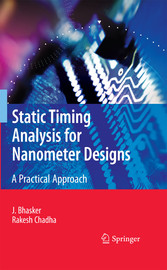Search and Find
Service
Contents
5
Preface
15
Introduction
21
1.1 Nanometer Designs
21
1.2 What is Static Timing Analysis?
22
1.3 Why Static Timing Analysis?
24
1.4 Design Flow
25
1.4.1 CMOS Digital Designs
25
1.4.2 FPGA Designs
28
1.4.3 Asynchronous Designs
28
1.5 STA at Different Design Phases
29
1.6 Limitations of Static Timing Analysis
29
1.7 Power Considerations
32
1.8 Reliability Considerations
33
1.9 Outline of the Book
33
STA Concepts
35
2.1 CMOS Logic Design
35
2.1.1 Basic MOS Structure
35
2.1.2 CMOS Logic Gate
36
2.1.3 Standard Cells
38
2.2 Modeling of CMOS Cells
40
2.3 Switching Waveform
43
2.4 Propagation Delay
45
2.5 Slew of a Waveform
48
2.6 Skew between Signals
50
2.7 Timing Arcs and Unateness
53
2.8 Min and Max Timing Paths
54
2.9 Clock Domains
56
2.10 Operating Conditions
59
Standard Cell Library
63
3.1 Pin Capacitance
64
3.2 Timing Modeling
64
3.2.1 Linear Timing Model
66
3.2.2 Non-Linear Delay Model
67
3.2.3 Threshold Specifications and Slew Derating
73
3.3 Timing Models - Combinational Cells
76
3.3.1 Delay and Slew Models
77
3.3.2 General Combinational Block
79
3.4 Timing Models - Sequential Cells
80
3.4.1 Synchronous Checks: Setup and Hold
82
3.4.2 Asynchronous Checks
86
3.4.3 Propagation Delay
88
3.5 State- Dependent Models
90
3.6 Interface Timing Model for a Black Box
93
3.7 Advanced Timing Modeling
95
3.7.1 Receiver Pin Capacitance
96
3.7.2 Output Current
99
3.7.3 Models for Crosstalk Noise Analysis
100
3.7.4 Other Noise Models
107
3.8 Power Dissipation Modeling
108
3.8.1 Active Power
108
3.8.2 Leakage Power
112
3.9 Other Attributes in Cell Library
114
3.10 Characterization and Operating Conditions
116
3.10.1 Derating using K-factors
117
3.10.2 Library Units
119
Interconnect Parasitics
121
4.1 RLC for Interconnect
122
4.2 Wireload Models
125
4.2.1 Interconnect Trees
128
4.2.2 Specifying Wireload Models
130
4.3 Representation of Extracted Parasitics
133
4.3.1 Detailed Standard Parasitic Format
133
4.3.2 Reduced Standard Parasitic Format
135
4.3.3 Standard Parasitic Exchange Format
137
4.4 Representing Coupling Capacitances
138
4.5 Hierarchical Methodology
139
4.6 Reducing Parasitics for Critical Nets
140
Delay Calculation
142
5.1 Overview
142
5.1.1 Delay Calculation Basics
142
5.1.2 Delay Calculation with Interconnect
144
5.2 Cell Delay using Effective Capacitance
145
5.3 Interconnect Delay
150
5.4 Slew Merging
154
5.5 Different Slew Thresholds
156
5.6 Different Voltage Domains
159
5.7 Path Delay Calculation
159
5.7.1 Combinational Path Delay
160
5.7.2 Path to a Flip- flop
162
5.7.3 Multiple Paths
164
5.8 Slack Calculation
165
Crosstalk and Noise
166
6.1 Overview
167
6.2 Crosstalk Glitch Analysis
169
6.2.1 Basics
169
6.2.2 Types of Glitches
171
6.2.3 Glitch Thresholds and Propagation
172
6.2.4 Noise Accumulation with Multiple Aggressors
179
6.2.5 Aggressor Timing Correlation
179
6.2.6 Aggressor Functional Correlation
181
6.3 Crosstalk Delay Analysis
183
6.3.1 Basics
183
6.3.2 Positive and Negative Crosstalk
186
6.3.3 Accumulation with Multiple Aggressors
188
6.3.4 Aggressor Victim Timing Correlation
188
6.3.5 Aggressor Victim Functional Correlation
190
6.4 Timing Verification Using Crosstalk Delay
190
6.4.1 Setup Analysis
191
6.4.2 Hold Analysis
192
6.5 Computational Complexity
194
6.6 Noise Avoidance Techniques
195
Configuring the STA Environment
197
7.1 What is the STA Environment?
198
7.2 Specifying Clocks
199
7.2.1 Clock Uncertainty
204
7.2.2 Clock Latency
206
7.3 Generated Clocks
208
7.4 Constraining Input Paths
219
7.5 Constraining Output Paths
223
7.6 Timing Path Groups
225
7.7 Modeling of External Attributes
228
7.7.1 Modeling Drive Strengths
229
7.7.2 Modeling Capacitive Load
232
7.8 Design Rule Checks
233
7.9 Virtual Clocks
235
7.10 Refining the Timing Analysis
237
7.10.1 Specifying Inactive Signals
238
7.10.2 Breaking Timing Arcs in Cells
239
7.11 Point-to-Point Specification
240
7.12 Path Segmentation
242
Timing Verification
244
8.1 Setup Timing Check
245
8.1.1 Flip-flop to Flip-flop Path
248
8.1.2 Input to Flip- flop Path
254
8.1.3 Flip- flop to Output Path
259
8.1.4 Input to Output Path
261
8.1.5 Frequency Histogram
263
8.2 Hold Timing Check
265
8.2.1 Flip- flop to Flip-flop Path
269
8.2.2 Input to Flip-flop Path
271
8.2.3 Flip- flop to Output Path
273
8.2.4 Input to Output Path
276
8.3 Multicycle Paths
277
8.4 False Paths
289
8.5 Half-Cycle Paths
291
8.6 Removal Timing Check
294
8.7 Recovery Timing Check
296
8.8 Timing across Clock Domains
298
8.8.1 Slow to Fast Clock Domains
298
8.8.2 Fast to Slow Clock Domains
306
8.9 Examples
312
8.10 Multiple Clocks
322
8.10.1 Integer Multiples
322
8.10.2 Non-Integer Multiples
325
8.10.3 Phase Shifted
331
Interface Analysis
334
9.1 IO Interfaces
334
9.1.1 Input Interface
335
9.1.2 Output Interface
340
9.1.3 Output Change within Window
345
9.2 SRAM Interface
353
9.3 DDR SDRAM Interface
358
9.3.1 Read Cycle
360
9.3.2 Write Cycle
365
9.4 Interface to a Video DAC
377
Robust Verification
381
10.1 On-Chip Variations
381
10.2 Time Borrowing
393
10.3 Data to Data Checks
401
10.4 Non-Sequential Checks
408
10.5 Clock Gating Checks
410
10.6 Power Management
428
10.6.1 Clock Gating
429
10.6.2 Power Gating
430
10.6.3 Multi Vt Cells
432
10.6.4 Well Bias
433
10.7 Backannotation
434
10.7.1 SPEF
434
10.7.2 SDF
434
10.8 Sign-off Methodology
434
10.9 Statistical Static Timing Analysis
438
10.9.1 Process and Interconnect Variations
439
10.9.2 Statistical Analysis
443
10.10 Paths Failing Timing?
449
10.11 Validating Timing Constraints
460
SDC
463
A. 1 Basic Commands
464
A.2 Object Access Commands
465
A.3 Timing Constraints
469
A.4 Environment Commands
477
A. 5 Multi-Voltage Commands
482
Standard Delay Format ( SDF)
483
B. 1 What is it?
484
B.2 The Format
487
B.2.1 Examples
501
B.3 The Annotation Process
511
B. 3.1 Verilog HDL
512
B.3.2 VHDL
515
B.4 Mapping Examples
517
B.5 Complete Syntax
535
Standard Parasitic Extraction Format ( SPEF)
547
C.1 Basics
547
C. 2 Format
550
C. 3 Complete Syntax
566
Bibliography
577
Index
579
All prices incl. VAT












